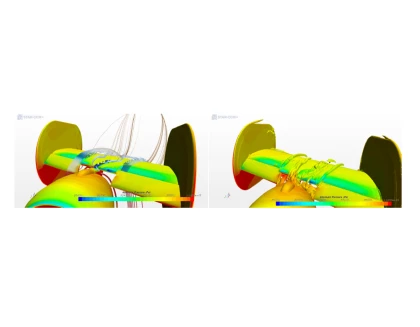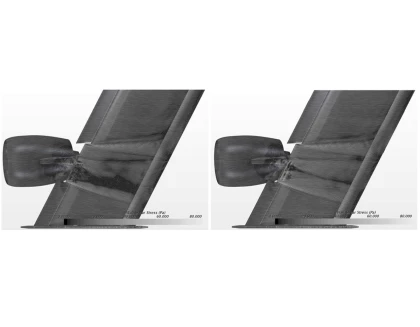
Background
Ultra-High By-Pass Ratio (UHBR) engines require larger nacelle diameters than more conventional technologies to satisfy both increased By-Pass Ratio and lowered Fan Pressure Ratio. The increase in the nacelle diameter imposes to position the engine much closer to the wing than conventional engines to comply with ground clearance. This close-coupled integration impacts the positioning of the engine relative to the leading edge of the wing, as well as the design of both the pylon and the nacelle in order to limit the degradation of aerodynamic performance as a consequence of the increase in the induced drag and the partial loss of lift during take-off, initial climbing and landing.
Specifically, the aerodynamic interaction promoted by the nacelle/pylon/wing junction is a major issue which affects the performance of aircraft equipped with UHBR engines, in particular during low speed/moderate-to-high incidence flight phases. To this purpose, there is still a lack of thorough understanding of the complex vortex dynamics issued from the junction of the nacelle, the pylon and the wing in these critical flight phases. Indeed, this is a mandatory prerequisite to propose technical solutions to improve the nacelle design, and potentially to recover optimal aerodynamic performance during take-off and landing.
Among the above mentioned technical solutions, various passive flow control systems have been studied in recent years for implementation on UHBR engines: however, while they moderately improve the aerodynamic performance when operated at take-off or landing conditions, the aerodynamic efficiency of the aircraft at cruise flight is significantly penalized.
In this context, the development of innovative active flow control strategies in the region of the nacelle/pylon/wing junction appears as a promising alternative to the currently implemented passive flow control systems.
Strategy
In X-Pulse, a high-fidelity predictive CFD methodology was set up, able to efficiently and accurately predict the flow field around a complex geometry representative of a UHBR powerplant-equipped aircraft for real flight conditions.
Then, a robust volumetric Reduced Order Model (ROM) of Zero Net Mass Flow (ZNMF) actuators, also known as Synthetic Jet Actuators (SJA), was derived, able to predict their impact on the flow field induced by the nacelle-powerplant-wing junction in terms of control of the flow separation. The model is based on body force source terms in replacement of more standard approaches in which the full SJA cavity is modelled or a velocity inlet boundary conditions is applied at the exit orifice of the SJA.
Using this ROM, a large number of different configurations and distributions of SJA over the wing/pylon was analysed and pertinent parametric studies were carried out on the main quantities governing the flow control (i.e. actuation location, momentum coefficient, outlet geometries, actuation frequency and amplitude modulation). The objective of the studies was to minimise flow separation and improve the aerodynamic performance during take-off, initial climbing and landing. The efficiency of the flow control was defined as the ratio of surface area affected by flow detachment with flow control on and off, based on the wall shear stress values.
Outcomes
A maximum efficiency gain of 86% was achieved at 16 deg angle of attack (incipient stall conditions) using two rows of 84 and 85 SJAs respectively over the wing near the pylon junction at the nominal jet momentum corresponding to a 256m/s jet velocity. Specifically, flow control was highly efficient in almost fully suppressing the separation zones induced by the UHBR powerplant installation. In light of this, the wing stall was significantly postponed with respect to the non-actuated configuration (from 12.5 deg to 21 deg).
A second study on the actuators momentum coefficient showed that flow control system tended to still be efficient even when the velocity of the pulsed jets was reduced to 170m/s.
A further parametric analysis was performed regarding the actuators flow angle and it was found that its effect on the efficiency of flow control is far less significant than the effect of varying the momentum coefficient. The optimal value was 20 deg for the first row of actuators: below this value, the efficiency of the actuators is jeopardized and hardly controllable. Also the angle of the second row was found to have an impact on efficiency of flow control, even though less significant than the first one. An optimal configuration was identified (α1=20°, α2=22°), which provided an efficiency of 87.3%.
Finally, a methodology was implemented to determine a correspondence between the pulsation and the desired mean velocity of a synthetic pulsed jet, based on the actual mean speed and the entrained fluid in the jet and using the state-of-the-art entrainment rate metrics. As a result, a suitable steady-state reduced model with equivalent entrainment level of a realistic unsteady jet was provided.
Duration: Duration: February 2017-October 2020
This project has received funding from the Clean Sky 2 Joint Undertaking (JU) under grant agreement No. 738172






